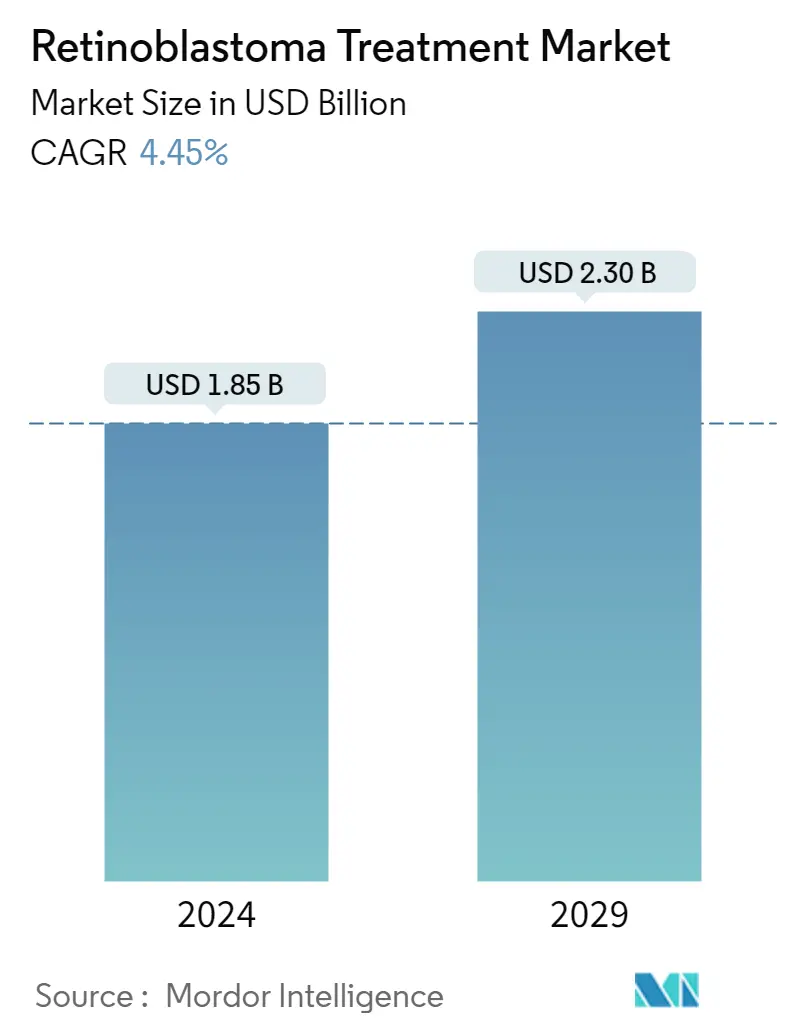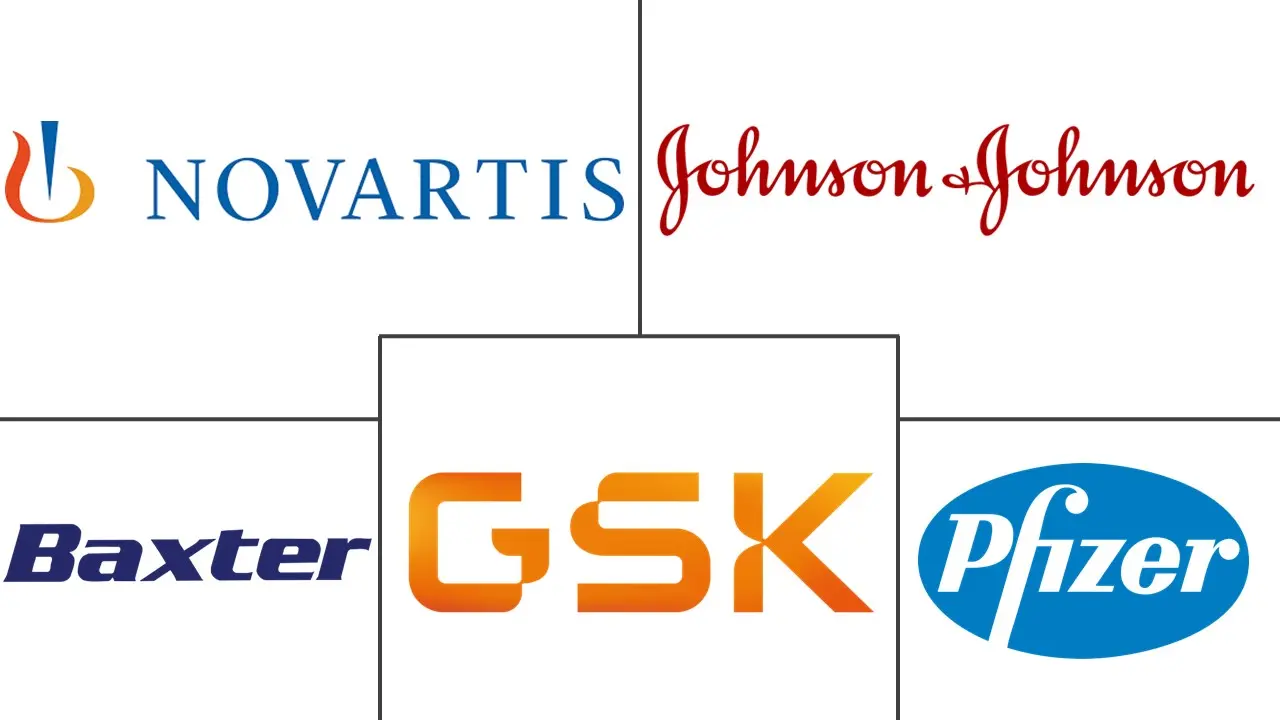Market Size of Retinoblastoma Treatment Industry

| Study Period | 2019 - 2029 |
| Market Size (2024) | USD 1.85 Billion |
| Market Size (2029) | USD 2.30 Billion |
| CAGR (2024 - 2029) | 4.45 % |
| Fastest Growing Market | Asia-Pacific |
| Largest Market | North America |
Major Players
*Disclaimer: Major Players sorted in no particular order |
Retinoblastoma Treatment Market Analysis
The Retinoblastoma Treatment Market size is estimated at USD 1.85 billion in 2024, and is expected to reach USD 2.30 billion by 2029, growing at a CAGR of 4.45% during the forecast period (2024-2029).
The COVID-19 pandemic created a significant void in the availability and accessibility of treatment modalities and timely intervention for children with eye cancer. For instance, according to an article published by the Indian Journal of Ophthalmology, in September 2021, the COVID-19-related nationwide lockdown deprived retinoblastoma patients of optimal and timely management, leading to prolonged treatment interruptions. Thus, COVID-19 had an impact on the retinoblastoma treatment market. However, with the decreasing number of COVID-19 cases, the demand for ophthalmic treatment and surgeries increased. For instance, according to an article published by the American Academy of Ophthalmology in November 2021, patients began pouring in with advanced eye cancers in October 2021, and there was an alarming rise in patients that required enucleation. Further, according to the same source, more young children with advanced cases of retinoblastoma were observed in the hospitals in Philadelphia. Hence, with the declining COVID-19 cases, there was an increase in retinoblastoma treatments, thereby fueling market growth, and the same is expected over the forecast period.
Certain factors driving the market growth include remission and the chance of recurrence of retinoblastoma and increasing public awareness of retinoblastoma. For instance, according to an article published by Bone Report, in December 2021, recurrence of retinoblastoma usually occurs within the first few years after treatment. Despite complete tumor regression, delayed relapse of retinoblastoma can occur, predisposing patients to osteosarcoma as a second malignancy. Furthermore, according to an article published by the National Library of Medicine in June 2021, Kaplan-Meier's estimate of tumor recurrence at six months, one year, three years, and five years was 20%, 31%, 68%, and 73%, respectively in 2021. Thus, the remission and the chance of recurrence of retinoblastoma are expected to boost market growth.
Furthermore, every year, to raise awareness, the 2nd week of May is observed as "World Retinoblastoma Awareness Week" around the World. It is an opportunity to raise global awareness of retinoblastoma, a life-threatening eye cancer that is almost exclusively found in young children every year. Hence, rising awareness regarding diseases is projected to boost market growth over the forecast period.
However, the side effects of retinoblastoma surgery and the high cost of treatment in developing countries are likely to hinder market growth over the forecast period.
Retinoblastoma Treatment Industry Segmentation
As per the scope of the report, Retinoblastoma is a rare type of eye cancer that usually develops in early childhood, typically before the age of 5. The most common symptom of retinoblastoma is a visible whiteness in the pupil, called a cat's eye reflex or leukocoria.
The Retinoblastoma Treatment Market is Segmented by Treatment Type (Surgery, Radiation therapy, Laser therapy, Cryotherapy, Chemotherapy, and Bone Marrow Transplantation/Stem Cell Transplant), Type of Retinoblastoma (Non-hereditary Retinoblastoma, and Hereditary Retinoblastoma), Type of Staging (Intraocular Retinoblastoma, and Extraocular Retinoblastoma), and Geography (North America, Europe, Asia-Pacific, Middle East and Africa, and South America). The market report also covers the estimated market sizes and trends for 17 countries across major regions globally. The report offers the value (USD million) for the above segments.
| By Treatment Type | |
| Surgery | |
| Radiation therapy | |
| Laser Therapy | |
| Cryotherapy | |
| Chemotherapy | |
| Bone Marrow Transplantation/Stem Cell Transplant |
| By Type of Retinoblastoma | |
| Non-hereditary Retinoblastoma | |
| Hereditary Retinoblastoma |
| By Type of Staging | |
| Intraocular Retinoblastoma | |
| Extraocular Retinoblastoma |
| Geography | ||||||||
| ||||||||
| ||||||||
| ||||||||
| ||||||||
|
Retinoblastoma Treatment Market Size Summary
The retinoblastoma treatment market is poised for growth, driven by increasing awareness and advancements in treatment modalities. The market is recovering from the disruptions caused by the COVID-19 pandemic, which had previously hindered timely interventions for children with this eye cancer. As the demand for ophthalmic treatments and surgeries rises, the market is expected to expand steadily over the forecast period. Factors such as the chance of recurrence and public awareness campaigns, like World Retinoblastoma Awareness Week, are contributing to this growth. The market is also seeing a rise in cases of non-hereditary retinoblastoma, which is further propelling demand for treatment options. Innovations in intra-arterial chemotherapy are enhancing treatment efficacy, particularly for unilateral retinoblastoma, thereby driving segmental growth.
North America holds a significant share of the retinoblastoma treatment market, with expectations of continued dominance due to its status as the most common primary intraocular malignancy in infants and children. The region benefits from increased regulatory approvals for cancer treatments, which are anticipated to bolster market expansion. The competitive landscape is moderately active, with both global and regional companies like Baxter International, GlaxoSmithKline, Pfizer, Johnson & Johnson, and Novartis AG playing key roles. Recent research developments, such as the discovery of molecular markers and the identification of tumor-promoting molecules, are expected to further advance treatment options and drive market growth. Despite challenges like high treatment costs in developing countries, the overall outlook for the retinoblastoma treatment market remains positive.
Retinoblastoma Treatment Market Size - Table of Contents
-
1. MARKET DYNAMICS
-
1.1 Market Overview
-
1.2 Market Drivers
-
1.2.1 Remission and the Chance of Recurrence of Retinoblastoma
-
1.2.2 Increasing Public Awareness on Retinoblastoma
-
-
1.3 Market Restraints
-
1.3.1 Side Effects of Retinoblastoma Surgery and High Cost of Treatment in Developing Countries
-
-
1.4 Porter's Five Forces Analysis
-
1.4.1 Threat of New Entrants
-
1.4.2 Bargaining Power of Buyers/Consumers
-
1.4.3 Bargaining Power of Suppliers
-
1.4.4 Threat of Substitute Products
-
1.4.5 Intensity of Competitive Rivalry
-
-
-
2. MARKET SEGMENTATION (Market Size by Value - USD Million)
-
2.1 By Treatment Type
-
2.1.1 Surgery
-
2.1.2 Radiation therapy
-
2.1.3 Laser Therapy
-
2.1.4 Cryotherapy
-
2.1.5 Chemotherapy
-
2.1.6 Bone Marrow Transplantation/Stem Cell Transplant
-
-
2.2 By Type of Retinoblastoma
-
2.2.1 Non-hereditary Retinoblastoma
-
2.2.2 Hereditary Retinoblastoma
-
-
2.3 By Type of Staging
-
2.3.1 Intraocular Retinoblastoma
-
2.3.2 Extraocular Retinoblastoma
-
-
2.4 Geography
-
2.4.1 North America
-
2.4.1.1 United States
-
2.4.1.2 Canada
-
2.4.1.3 Mexico
-
-
2.4.2 Europe
-
2.4.2.1 Germany
-
2.4.2.2 United Kingdom
-
2.4.2.3 France
-
2.4.2.4 Italy
-
2.4.2.5 Spain
-
2.4.2.6 Rest of Europe
-
-
2.4.3 Asia-Pacific
-
2.4.3.1 China
-
2.4.3.2 Japan
-
2.4.3.3 India
-
2.4.3.4 Australia
-
2.4.3.5 South Korea
-
2.4.3.6 Rest of Asia-Pacific
-
-
2.4.4 Middle East and Africa
-
2.4.4.1 GCC
-
2.4.4.2 South Africa
-
2.4.4.3 Rest of Middle East and Africa
-
-
2.4.5 South America
-
2.4.5.1 Brazil
-
2.4.5.2 Argentina
-
2.4.5.3 Rest of South America
-
-
-
Retinoblastoma Treatment Market Size FAQs
How big is the Retinoblastoma Treatment Market?
The Retinoblastoma Treatment Market size is expected to reach USD 1.85 billion in 2024 and grow at a CAGR of 4.45% to reach USD 2.30 billion by 2029.
What is the current Retinoblastoma Treatment Market size?
In 2024, the Retinoblastoma Treatment Market size is expected to reach USD 1.85 billion.

